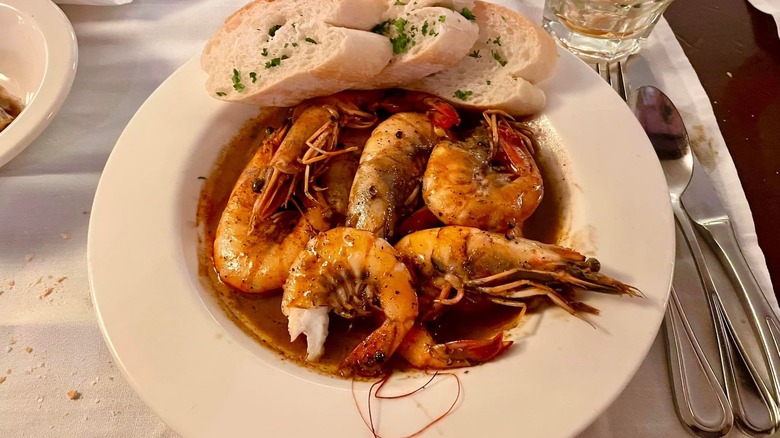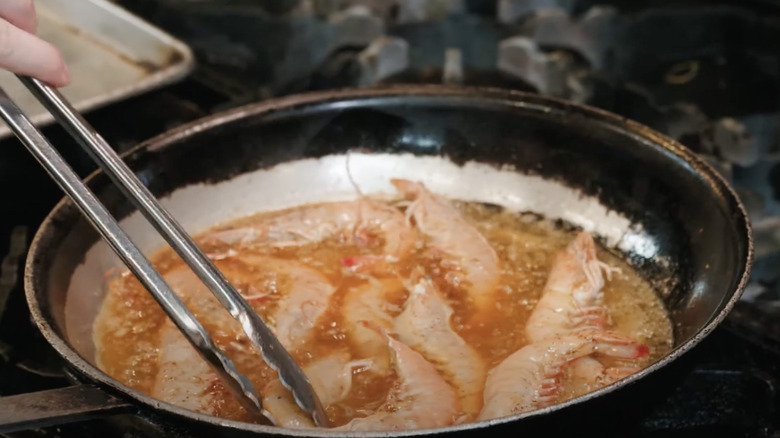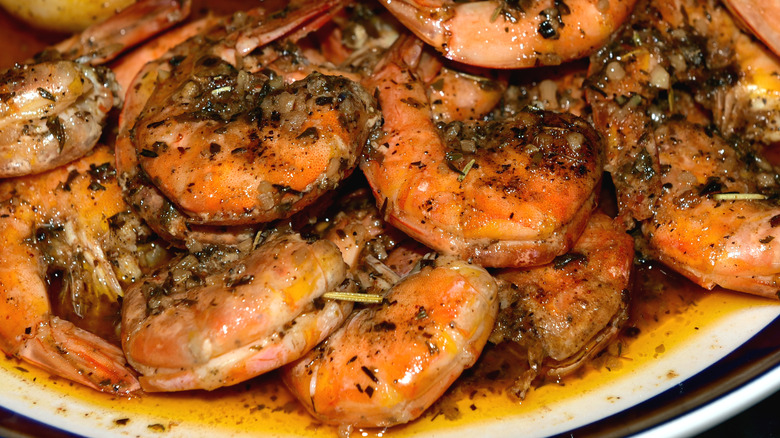New Orleans-Style Barbecue Shrimp Never Actually Touches A Grill
Barbecuing is, of course, a beloved American culinary pastime based around cooking foods on the grill (or, historically, right over a fire). Shrimp prepared this way can be the highlight of any cookout, but there's a version of "barbecue shrimp" hailing from New Orleans that never sees the flickering flames or smoldering coals of a grill at all. Instead, the regional specialty gets cooked the same way it always has — sauteed in a pan — since its creation at Pascal's Manale, a family-run restaurant near the Big Easy's Garden District neighborhood.
The "barbecue" in question refers not to an actual barbecue grill but to the color of the sauce that the shrimp are tossed and cooked in, which ends up somewhere between a ruddy beige and a rusty brown, depending on the spices used. And while barbecue sauce has a history that precedes America's founding, the ubiquitous, sweet Kansas City-style stuff, at least, didn't start tantalizing taste buds nationally until the last quarter of the 20th century. That makes the base for this sauteed shrimp dish one of the first renowned American barbecue sauces. The lack of a grill allows the shrimp to soak up as much of the highly seasoned sauce as possible.
Goodbye grill, hello saucy saute pan
New Orleans kitchens are famous for a range of robustly flavored foods, but perhaps none so much as their seafood dishes. Gumbo, crawfish étouffée, jambalaya — it's a long list, and barbecue shrimp is absolutely a part of that heritage.
Unlike a lot of famous American dishes that have competing origin stories, we actually know exactly when and where barbecue shrimp first came to be: At Pascal's Manale in 1953. The origin story of how red beans and rice became such an intricate part of Mardi Gras may be up for debate, but pretty much everyone agrees that the popular Creole-Italian restaurant gets credit for coming up with barbecue shrimp. The shellfish are traditionally cooked and served with the heads still on. They simmer in that crucial sauce, a rich, smoky, butter-based concoction loaded with Worcestershire sauce, black pepper, and lemon juice (and sometimes beer or wine). The pan is essential for cooking down and thickening the sauce as the shrimp mingle with all those flavors.
If you can't get or don't want to deal with head-on shrimp, there are other options. Emeril Lagasse, for instance, has a version of barbecue shrimp with biscuits that calls for the shrimp to cook entirely without shells, instead using the pieces of shell to create a wine-based sauce.
New Orleans-style barbecue shrimp is easily adaptable
In contrast to the other components of the sauce, the spices used for barbecue shrimp can vary wildly. Black pepper is a must, but you'll also see mixtures involving paprika, onion powder, rosemary, thyme, basil, garlic powder, cayenne, oregano, cumin, chili powder, and sugar — it's a versatile dish. If you don't have access to head-on shrimp, the best way to make up for it, according to former Pascal's Manale co-owner and chef Mark DeFelice (in conversation with NPR), is simply by adding extra seasoning. Since a lot of the fat and protein of the shrimp is located in the heads, you won't notice their absence as much.
It isn't just seasoning that varies, either, as there are all sorts of preparation methods. Pairing barbecue shrimp with cheese and bacon grits marries that tangy BBQ flavor with the rich creaminess of cheesy grits and smoky pork, while BBQ shrimp with a smoked gouda grit cake has a similar vibe for those who prefer a sturdier way of serving cornmeal. You can also simply grab a loaf of French bread for dipping (either directly into the sauce or stuffed with saucy shrimp). So, if you want to make your own New Orleans-style barbecue shrimp, feel free to get creative — as long as you're bold with the flavors, you'll be sticking to that fine old New Orleans culinary tradition. Just make sure to keep those shellfish far, far away from the grill.


